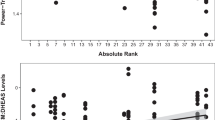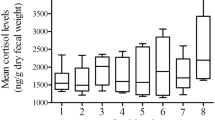Abstract
Rationale
Hypothalamic-pituitary-adrenal (HPA) axis activity under different social settings in non-human primates is understudied.
Objective
The aim of this study is to evaluate the response of pituitary-adrenal hormones (adrenocorticotropic hormone (ACTH) and cortisol) to pharmacological challenges of the HPA axis in male cynomolgus macaques under different social settings.
Methods
Male cynomolgus macaques (Macaca fascicularis, n = 11) were individually (A) and socially housed (B) in alternation, over consecutive months, in an ABA design. During each experimental phase, plasma ACTH and cortisol were measured in response to low- and mild-intensity psychological stressors and following administration of saline, naloxone, ovine-corticotropin-releasing factor (oCRF), and dexamethasone.
Results
These data demonstrate that cortisol measured under low stress conditions is sensitive to social rank (dominance hierarchy) and distinguishes dominant from non-dominant animals during both individual and social settings. Administration of naloxone resulted in elevated circulating ACTH and cortisol, while oCRF only increased circulating cortisol. During social housing, the cortisol response to naloxone and oCRF was increased, whereas dexamethasone suppression of ACTH and cortisol remained consistent across all social settings.
Conclusions
Circulating ACTH and cortisol are differentially sensitive to changes in social settings in non-human primates. Cortisol response increased during social housing and could be stimulated by both naloxone and oCRF, whereas ACTH response was generally not influenced by social setting or oCRF but was increased by naloxone. These data show differential adrenal and pituitary response to changes in social settings and a small, but consistent, effect of social dominance.




Similar content being viewed by others
References
Abbott DH, Keverne EB, Bercovitch FB, Shively CA, Mendoza SP, Saltzman W, Snowdon CT, Ziegler TE, Banjevic M, Garland T, Sapolsky RM (2003) Are subordinates always stressed? A comparative analysis of rank differences in cortisol levels among primates. Hormones & Behavior 43(1):67–82
Adinoff B, Krebaum SR, Chandler PA, Ye W, Brown MB, Williams MJ (2005) Dissection of hypothalamic-pituitary-adrenal axis pathology in 1-month-abstinent alcohol-dependent men, part 2: response to ovine corticotropin-releasing factor and naloxone. ACER 29(4):528–537
Adinoff B, Best SE, Ye W, Williams MJ, Iranmenesh A (2010) Adrenocortical and pituitary glucocorticoid feedback in abstinent alcohol-dependent women. ACER 34(5):915–924
Becker HC, Lopez MF, Doremus-Fitzwater TL (2011) Effects of stress on alcohol drinking: a review of animal studies. Psychopharmacology 218(1):131–156
Bentson KL, Capitanio JP, Mendoza SP (2003) Cortisol response to immobilization with Telazol or ketamine in baboons (Papio cynocephalus/Anubis) and rhesus macaques (Macaca mulatta). J Med Primatol 32(3):148–160
Cohen S, Line S, Manuck SB, Rabin BS, Heise ER, Kaplan JR (1997) Chronic social stress, social status and susceptibility to upper respiratory infections in nonhuman primates. Psychosom Med 59(3):213–221
Core Team R (2015) R: a language and environment for statistical computing. R Foundation for Statistical Computing, Vienna. URL http://www.R-project.org/ .
Czoty PW, Gould RW, Nader MA (2009) Relationship between social rank and cortisol and testosterone concentrations in male cynomolgus monkeys (Macaca fascicularis). J Neuroendocrinol 21(1):68–76
Edwards AV, Jones CT (1987) The effect of splanchnic nerve stimulation on adrenocortical activity in conscious calves. J Physiol 382:385–396
Flack JC, Jeannotte LA, de Waal FB (2004) Play signaling and the perception of social rules by juvenile chimpanzees (Pan troglodytes). J Comp Psychol 118(2):149–159
Foley R, Gamble C (2009) The ecology of social transitions in human evolution. Philos Trans R Soc Lond Ser B Biol Sci 364(1533):3267–3279
Fuchs E, Jöhren O, Flügge G (1993) Psychosocial conflict in the tree shrew: effects on sympathoadrenal activity and blood pressure. Psychoneuroendocrinology 18(8):557–565
Gesquiere LR, Onyango PO, Alberts SC, Altmann J (2011) Endocrinology of year-round reproduction in a highly seasonal habitat: environmental variability in testosterone and glucocorticoids in baboon males. Am J Phys Anthropol 144(2):169–176
Goo GP, Sassenrath N (1980) Persistent adrenocortical activation in female rhesus monkeys after new breeding groups formation. J Med Primatol 9(6):325–334
Grant KA, Shively CA, Nader MA, Ehrenkaufer RL, Line SW, Morton TE, Gage HD, Mach RH (1998) Effect of social status on striatal dopamine D2 receptor binding characteristics in cynomolgus monkeys assessed with positron emission tomography. Synapse 29(1):80–83
Grant KA, Leng X, Green HL, Szeliga KT, Rogers LSM, Gonzales SW (2008) Drinking typography established by scheduled induction predicts chronic heavy drinking in a monkey model of ethanol self-administration. ACER 32(10):1824–1838
Helms CM, Messaoudi I, Jeng S, Freeman WM, Vrana KE, Grant KA (2012a) A longitudinal analysis of circulating stress-related proteins and chronic ethanol self-administration in cynomolgus macaques. ACER 36(6):995–1003
Helms CM, McClintick MN, Grant KA (2012b) Social rank, chronic ethanol self-administration, and diurnal pituitary-adrenal activity in cynomolgus monkeys. Psychopharmacology 224(1):133–143
Helms CM, Gonzales SW, Green HL, Szeliga KT, Rogers LSM, Grant KA (2013) Diurnal pituitary-adrenal activity during schedule-induced polydipsia of water and ethanol in cynomolgus monkeys (Macaca fascicularis). Psychopharmacology 228:541–549
Henry JP, Stephens PM (1977) Stress, health, and the social environment. A sociobiological approach to medicine. Springer Verlag, New York
Hergovich N, Singer MD, Agneter E, Eichler GH, Graselli U, Simhandi C, Jilma B (2001) Comparison of the effects of ketamine and memantine on prolactin and cortisol release in men: a randomized, double-blind, placebo-controlled trial. Neuropsychopharmacology 24:590–593
Higley JD, Suomi SJ, Linnoila M (1992) A longitudinal assessment of CSF monoamine metabolite and plasma cortisol concentrations in young rhesus monkeys. Biol Psychiatry 32(2):127–145
Hothorn T, Bretz F, Westfall P (2008) Simultaneous inference in general parametric models. Biom J 50(3):346–363
Jimenez VA, Helms CM, Cornea A, Meshul CK, Grant KA (2015) An ultrastructural analysis of the effects of ethanol self-administration on the hypothalamic paraventricular nucleus in rhesus macaques. Frontiers Cellular Neuroscience 9:1–14. doi:10.3389/fncel.2015.00260
Kalin NH, Cohen RM, Kraemer GW, Risch SC, Shelton S, Cohen M, McKinney WT, Murphy DL (1981) The dexamethasone suppression test as a measure of hypothalamic-pituitary feedback sensitivity and its relationship to behavioral arousal. Neuroendocrinology 32(2):92–95
Kaplan JR, Adams MR, Koritnik DR, Rose JC, Manuck SB (1986) Adrenal responsiveness and social status in intact and ovariectomized Macaca fascicularis. Am J Primatol 11:181–193
Leshner AI, Candland DK (1972) Endocrine effects of grouping and dominance rank in squirrel monkeys. Physiol Behav 8(3):441–445
Lyons DM, Martel FL, Levine S, Risch NJ, Schatzberg AF (1999) Postnatal experiences and genetic effects on squirrel monkey social affinities and emotional distress. Hormones & Behavior 36(3):266–275
Malaivijitnod S, Takenaka O, Sankai T, Yoshida T, Cho F, Yoshikawa Y (1998) Effects of single and multiple injections of ketamine hydrochloride on serum hormone concentration in male cynomolgus monkeys. Lab Anim Sci 48(3):270–274
Mason JW (1959) Psychological influences on the pituitary-adrenal cortical system. Recent Prog Horm Res 15:345–389
Mendoza SP, Coe CL, Lowe EL, Levine S (1978) The physiological response to group formation in adult male squirrel monkeys. Psychoneuroendocrinology 3(3):221–229
Michopoulos V, Reding KM, Wilson M, Toufexis D (2012) Social subordination impairs hypothalamic-pituitary-adrenal function in female rhesus monkeys. Hormones & Behavior. 62(4):389–399
Morgan D, Grant KA, Prioleau OA, Nader SH, Kaplan JR, Nader MA (2000) Predictors of social status in cynomolgus monkeys (Macaca fascicularis) after group formation. Am J Primatol 52(3):115–131
Morgan D, Grant KA, Gage HD, Mach RH, Kaplan JR, Prioleau O, Nader SH, Buchheimer N, Ehrenkaufer RL, Nader MA (2002) Social dominance in monkeys: dopamine D2 receptors and cocaine self-administration. Nat Neurosci 5(2):169–174
Pinheiro J, Bates D, DebRoy S, Sarkar D and R Core Team (2016). nlme: Linear and Nonlinear Mixed Effects Models. R package version 3.1–124, < URL: http://CRAN.R-project.org/package=nlme
Porcu P, Grant KA, Green HL, Rogers LSM, Morrow AL (2006) Hypothalamic-pituitary-adrenal axis and ethanol modulation of deoxycorticosterone levels in cynomolgus monkeys. Psychopharmacology 186:293–301
Puri CP, Puri V, Anand Kumar TC (1981) Serum levels of testosterone, cortisol, prolactin and bioactive luteinizing hormone in adult male rhesus monkeys following cage-restraint or anaesthetizing with ketamine hydrochloride. Acta Endocrinol 97:118–124
Qin DD, Rizak JD, Feng XL, Chu XX, Yang SC, Li CL, Lu LB, Ma YY, Hu XT (2013) Social rank and cortisol among female rhesus macaques (Macaca mulatta). Zool Res 34(2):42–49
Riddick NV, Czoty PW, Gage HD, Kaplan JR, Nader SH, Icenhower M, Pierre PJ, Bennett A, Garg PK, Garg S, Nader MA (2009) Behavioral and neurobiological characteristics influencing social hierarchy formation in female cynomolgus monkeys. Neuroscience 158(4):1257–1265
Ruys JD, Mendoza SP, Capitanio JP, Mason WA (2004) Behavioral and physiological adaptation to repeated chair restraint in rhesus macaques. Physiol Behav 82:205–213. doi:10.1016/j.phybeh.2004.02.031
Sapolsky RM (1992) Cortisol concentrations and the social significance of rank instability among wild baboons. Psychoneuroendocrinology 17(6):701–709
Sassenrath EN (1970) Increased adrenal responsiveness to social stress in rhesus monkeys. Hormones & Behavior. 1:283–298
Shively C, Kaplan J (1984) Effects of social factors on adrenal weight and related physiology of Macaca fascicularis. Physiol Behav 33(5):777–782
Shively CA, Grant KA, Ehrenkaufer RL, Mach RH, Nader MA (1997) Social stress, depression, and brain dopamine in female cynomolgus monkeys. Ann N Y Acad Sci 15:574–577
Suomi, SJ (1976). Factors affecting responses to social separation in rhesus monkeys. Animal models in human psychobiology: 9–26
Vendruscolo LF, Estey D, Goodell V, Macshane LG, Logrip ML, Schlosberg JE, McGinn MA, Zamora-Martinez ER, Belanoff JK, Hunt HJ, Sanna PP, George O, Koob GF, Edwards S, Mason BJ (2015) Glucocorticoid receptor antagonism decreases alcohol seeking in alcohol-dependent individuals. J Clin Invest 3(125):3193–3197. doi:10.1172/JCI79828
Vivian JA, Green HL, Young JE, Majerksy LS, Thomas BW, Shively CA, Tobin JR, Nader MA, Grant KA (2001) Induction and maintenance of ethanol self-administration in cynomolgus monkeys (Macaca fascicularis): long-term characterization of sex and individual differences. ACER. 25(8):1087–1097
de Waal FB (1986) The integration of dominance and social bonding in primates. Q Rev Biol 61(4):459–479
Williams KL, Holden Ko MC, Rice KC, Woods JH (2003) Effect of opioid receptor antagonists on hypothalamic-pituitary-adrenal activity in rhesus monkeys. Psychoneuroendocrinology 28(4):513–528
Acknowledgements
This work and preparation of the manuscript was supported by AA103510, the supplement to AA013510 and OD11092. The authors wish to thank Dr. Christa Helms who provided initial analysis of the data.
Author information
Authors and Affiliations
Corresponding author
Rights and permissions
About this article
Cite this article
Jimenez, V.A., Allen, D.C., McClintick, M.N. et al. Social setting, social rank and HPA axis response in cynomolgus monkeys. Psychopharmacology 234, 1881–1889 (2017). https://doi.org/10.1007/s00213-017-4596-7
Received:
Accepted:
Published:
Issue Date:
DOI: https://doi.org/10.1007/s00213-017-4596-7




